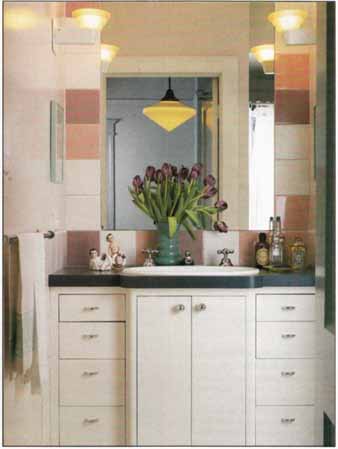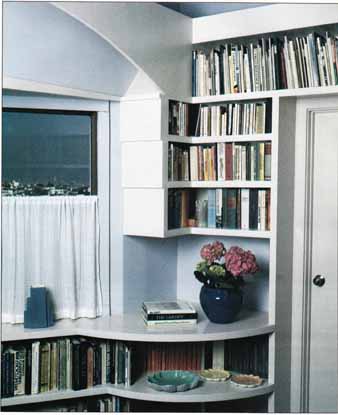Having decided on the amount of money, time, skill, and space available, you can now concentrate on selecting the right design.
Location, more than intended use, should determine the style you choose. If making a built-in case, you will almost certainly want to match the existing look of the area. Find trim that matches the molding and, if possible, knobs that either match or complement the others in the room.
Building a freestanding case opens many design possibilities. You can make a case that blends in with the existing furniture or use the new case to make a design statement—perhaps to set a new tone for the decor of the room. The photographs in this section show a wide variety of styles and are meant to serve as an idea book. If you see a style you like, plan to apply that style to the case you design, but first make some sketches to help you envision the completed project.
Choosing a location
The room in which the bookcase or cabinet is to be used will determine some of your decisions.
Living room. Living-room shelves and cabinets should be well de signed, constructed from attractive materials, and finely crafted with adjustable shelves for displaying books and art objects of various sizes. Cases for stereo or video equipment look clean and uncluttered when holes are made for routing wires.
Dining room. Cabinets will probably be used to store china and linens. Make sure shelves and drawers are deep enough and wide enough to house these items.
The dining room might also be the place for a bar cabinet. This could be an open case lined with mirrors and fitted with shelves, or a closed cabinet with doors painted to match the walls or made of wood that matches the dining table.
Den and library. These rooms may need several cases and cabinets to house books, a record collection, board games, and sewing supplies. Cases should be designed to incorporate areas that will show off attractive objects while concealing utilitarian ones.
Playroom. For a child’s playroom, you will probably want a simple, functional piece of furniture made of durable materials and finished with a painted, easy-to-clean surface.
Kitchen. Kitchen shelves should be fully adjustable for the most efficient use of space. The deeper shelves will accommodate cookware and small appliances, and vertically divided spaces are useful for storing trays and cookie sheets.
The finish should be easy to keep clean. Use paint that matches the walls, a clear polyurethane finish, or face the doors with plastic laminate.
Bathroom. As in the kitchen, bath room surfaces must be easy to keep clean. In addition the materials must be able to withstand moisture.
Most people find that several small drawers are more practical for storing toiletries than a few large ones. Small drawers also make it easier to fit storage areas around plumbing pipes and fixtures.
Workshop. In a workshop you’ll probably want fixed shelves in rugged materials that will take wear and tear and dirt. This is not the place for expensive, exotic woods.
Utility room. Like a workshop, this is a place where practicality is the main consideration. Shelves should be large enough to hold economy- sized cleaning supplies.
If this room also houses laundry equipment, make sure that space is provided for baskets, iron, and ironing board.
Entry. When decorating a home, don’t overlook the potential of an entrance hall. Considering that it is responsible for the first impression guests have of your house, it is a good place to make a statement.

In keeping with the playful attitudes of the current architectural
styles, these built-in shelves and cabinets make a more interesting statement
than would an ordinary rectangular shape.
This can be done by using a case filled with a special collection.
Corridor. If you have a corridor that is fairly wide, a row of bookcases can be a handsome and practical addition to a long corridor. It will visually foreshorten the corridor as well as add decorative interest.
Garage and shed. In addition to sturdy shelves for bulky items such as yard, patio, and outdoor equipment, these locations should have cabinets with locks if you will be storing insecticides, cleaning agents, and other dangerous chemicals.

Standard bathroom cabinets rarely allow for enough storage. When
you make your own, not only can you put in as many drawers and shelves
as will fit, but you can size them to suit particular needs.

These built-ins required careful planning, measuring, and constructing
as well as a saber saw to cut the curved edges.
Prev.: Getting Started
Next: Establishing
a Size
Full guide: How to Plan & Build Bookcases, Cabinets & Shelves
